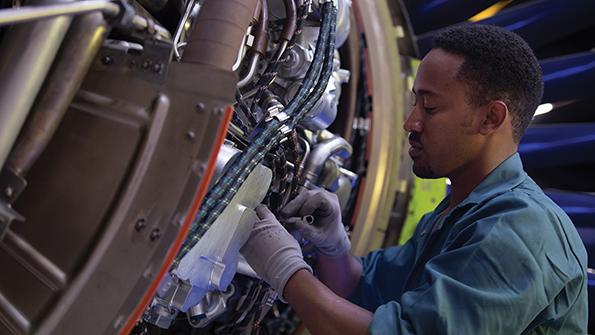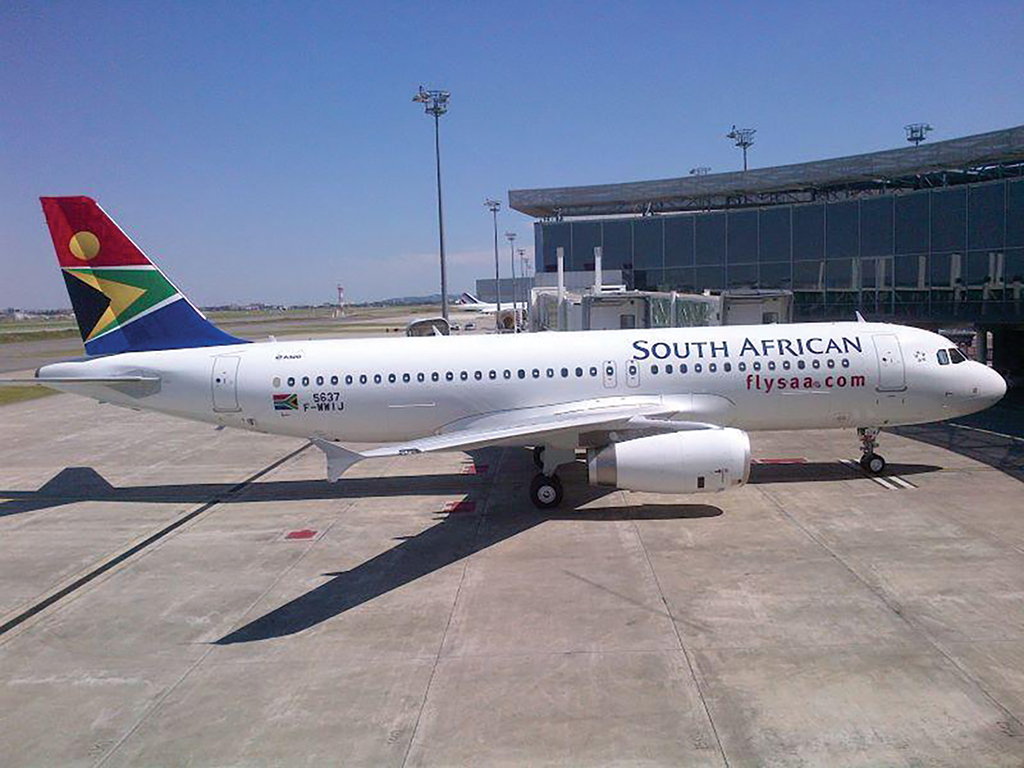
Airbus sees potential for Africa to create a licensing curriculum that is trusted across the whole continent.
"Give a man a fish and you feed him for a day. Teach a man to fish and you feed him for a lifetime.” This proverb mirrors a new Airbus initiative that aims to help African airlines strengthen local maintenance capabilities, reducing the need to ferry aircraft to other continents.
“If an African operator decides to go abroad to Europe, the U.S. or wherever [for maintenance], it should be by choice and not because there is not enough offered on the continent,” said Airbus African Support Strategy Project Leader Cheikh Diop during a recent webinar.
Airbus is not swooping in to fix Africa’s problems. Instead, the airframer wants African companies to take the lead, asking for help where needed.
“We want to push for Africa’s autonomy,” Diop said. “What we want to do is to facilitate solutions that will be designed by Africa, for Africa. We’re here to help—not the other way around, where people come and ask us to do [the work for them].”
Airbus has run other African support projects, but this initiative is more structured, with a longer-term perspective. “We’ve already started to make some concrete steps. And very clearly, we’re thinking big and wide,” Diop said.
Diop, an aeronautical engineer with Senegalese and Mauritanian roots, knows the African market firsthand. He sees a shortage of MRO capacity, particularly in West Africa, where there is high growth. However, MRO facilities in other regions of the continent are underutilized because operators often take their aircraft elsewhere for MRO.
“The first point is to understand the root cause,” Diop said. “Is it because they don’t trust existing facilities? Is it because they’re certified by an authority that maybe they don’t know? I have no idea. We need to understand this first, because if it is due to a lack of trust, maybe as an OEM we can help facilitate this level of trust by giving an independent view.” If the problem is that the facility lacks certifications or qualifications, Airbus may able be able to help with this as well.
Diop also sees a lack of collaboration among African MROs. He used Airbus’ own structure as a partnership between four countries to illustrate. “If [the Airbus partner countries] did not collaborate, I don’t know if we would be where we are today,” he said. “As a second example, we team up with all our competitors when we have to shape the industry of tomorrow.”
MRO MAPPING
Another task will be mapping the MRO players, understanding their competencies and ensuring this knowledge is shared and used across the continent. Similar work was done a few years back by the African Airlines Association (AFRAA), which hosted the webinar with Diop. Raphael Kuuchi, AFRAA consulting director for government, legal and industry affairs, said this existing African MRO database is available on the AFRAA website.
“Whenever we have technical and operations committee meetings, we try to remind members of the availability of existing MROs and why they need to make use of them,” Kuuchi said.
AFRAA itself is in the pilot phase of a spare-parts pooling initiative. As an element of this, AFRAA and SAA Technical are finalizing an agreement to create a components pool at Johannesburg O.R. Tambo International Airport. “Once the pilot becomes successful, we are looking at replicating that in other regions,” Kuuchi said. “Ethiopian Airlines has already indicated to AFRAA that they would be glad to do something similar using their base in Lome, [Togo], to take care of West Africa.”

Diop believes Airbus can also help with African parts availability. “We don’t want an aeroplane sitting there for days waiting for a part that could have been there within hours, should we have a spares pool available next door,” he said. Diop suggests that Airbus could help AFRAA solve any issues that it hits with the spare-parts pool, or simply step back if the initiative is working well.
The Airbus program head’s main concern is operators accidentally using the wrong part. “It’s very easy to think that ‘a glue is a glue,’ but a glue for one aircraft is not necessarily a glue for another aircraft,” he said. “It’s not for Airbus to come and build warehouses everywhere. It’s about us seeing how we can support these sorts of initiatives using existing warehouses, using existing players, but also, again, coming as a helping hand to make these great initiatives work.”
This will become even more relevant as Africa begins to harness its growth potential. “When we look ahead, we see all the ingredients for a booming market,” Diop said.
Airbus forecasts that the African commercial fleet will quadruple to around 1,200 aircraft over the next 20 years. Around 80% of these will be single-aisles for intra-African flights. However, many African airlines still operate classic-generation aircraft rather than new-generation models. This means there is a huge technology jump from classics to modern technologies such as Airbus A320neos.
SKIPPING A GENERATION
“It’s a straight jump, which is nice to see, but our role is to make sure that we accompany this jump in such a way that the knowledge transfer is also happening,” Diop said. “We need to make sure that this gap is not only understood but also properly staffed.”
The day-to-day focus of African operators means they sometimes lack resources to prepare fully for a new type’s entry into service. “For all our operators, when they take a new aircraft model, we are preparing them to know the aeroplane as early as possible. What we have realized is that for African operators, we have to do a bit more than usual,” Diop said. “We quite often realize after the entry into service that there are some gaps in there.”
Airbus is piloting an initiative to get to know its African airline customers “inside out” before the new aircraft delivery, with the aim of helping them through the initial acceptance process. “It’s not spying on the customer. It’s really to understand what support is needed,” Diop said. In practical terms, the airframer sends “a squad of knowledgeable people” to sit down with the operator and answer any questions, working through regulatory acceptance processes, planned aircraft deployment and warehouse locations.
There are further challenges once the aircraft is in service, because maintenance processes for new-technology aircraft are different from those for classic-generation aircraft. Diop cited the examples of structural damage assessments on metal aircraft versus composite and the increased use of digital tools to monitor performance.
“It’s not the same job anymore,” Diop said. “It is technically different, the tools are different, the assessment is different, and the results may be different on clearing an aeroplane [back into service], for instance. Our role is to make sure not only that this is understood, but that if it needs new skills, new resources, they are there.”
AFRICAN ADVANTAGE
Part of the Airbus African Support Strategy involves technical training, reducing Africa’s dependence on skills from abroad. However, this is where the continent has an advantage. Around 70% of the African population is below 30 years old and very eager to learn.
Diop also sees potential for Airbus to help harmonize training standards. While it is up to African universities to create their own courses, Airbus could facilitate partnerships between those universities, potentially connecting them with similar institutions in Europe.
Another area for development is African countries’ willingness to recognize and accept training from one another so that an aviation professional trained in South Africa can work in West Africa and vice versa. Airbus sees potential for Africa to create a licensing curriculum that is trusted across the whole continent. The OEM is willing to help make that happen, but only if that support is needed or wanted.
Airbus is in discussions with Ethiopian Airlines, which has its own aviation university offering technical training and leadership courses. “I also know that other countries want to do the same; they want to put some degrees in place,” Diop said. “We are in touch with some operators and some training organizations on the continent. The next step is to look at those who want to become training organizations. There’s a lot of willingness from many countries.”
Diop is keen to get the ball rolling, identify where Africa wants help, prioritize those projects and get started.
“We have a small window of time where we can be all convinced that this is worth the gain,” Diop said. “If in five years we haven’t progressed, we will all say: ‘OK, you know what? Let’s let it go. Nobody’s really willing to play the game.’ And I hope this won’t be the case.”
